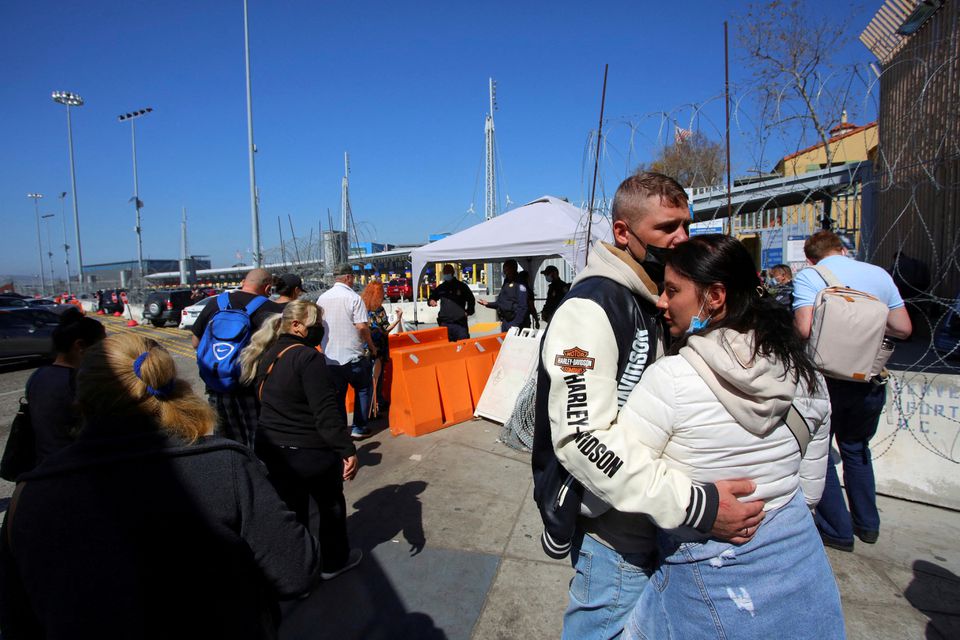
A Russian couple embrace as they wait for a humanitarian visa at the San Ysidro Port of Entry of the U.S.-Mexico border in Tijuana, Mexico March 15, 2022. Picture taken March 15, 2022. REUTERS/Jorge Duenes/File Photo
TIJUANA, Mexico – Russians trying to enter the United States at the Mexican border are frustrated they are not getting in like Ukrainians are, despite leaving their homeland over the invasion of Ukraine.
U.S. officials have let dozens of Ukrainians through this week but Russians remain in limbo, prompting some to camp on the pavement alongside a barbed wire border fence, defying warnings from Mexican authorities to leave.
Irina Zolkina, a math teacher who left Moscow with her four children and her daughter’s boyfriend, burst into tears when a U.S. border agent on Thursday took one look at her stack of Russian passports and shook his head, saying they would have to wait – soon after officials ushered in six Ukrainian men.
“There are so many years of fear that we’re living in … it’s awful inside Russia too,” she told Reuters in the Mexican border city of Tijuana opposite San Diego, California.
Zolkina showed Reuters a BBC video of her arrest for attending an anti-war protest on Feb. 24, the day Russia invaded Ukraine in what the Kremlin calls a “special military operation” that Western allies have denounced.
She was released a few hours later and left Russia with her children the following week, she said, passing through Tashkent and Istanbul before reaching the Mexican beach resort of Cancun – a common jumping-off point for Russians heading to the U.S. border.
Over 3 million Ukrainians have become refugees, according to the United Nations, most of them in countries bordering Ukraine. Thousands of Russians have also left their country, according to media reports.
Some Ukrainians crossing in Tijuana have been granted permission to stay in the United States for a year.
When asked on Thursday about Ukrainians and Russians at the border, U.S. Homeland Security Secretary Alejandro Mayorkas said the government was helping people fleeing Ukraine, and that other programs were being considered to expand humanitarian aid.
Ukrainians fleeing the Russian invasion of their homeland pass through a checkpoint to enter the United States after authorities granted permission to remain in the country until 2023, at the San Ysidro Port of Entry of the U.S.-Mexico border in Tijuana, Mexico March 17, 2022. REUTERS/Jorge Duenes/File Photo
The U.S.-Mexico border has been closed to most asylum seekers under a coronavirus pandemic policy.
A Department of Homeland Security spokesperson, asked about current policy towards Russians, said the agency makes exceptions to the order on a case-by-case basis for “particularly vulnerable individuals.”
‘UNFAIR’
A couple of dozen other Russians have for several days wrapped themselves in thick blankets to sleep feet from the border wall, hoping U.S. officials will hear their pleas for protection.
“It’s unfair that we can’t get in,” said Mark, 32, a restaurant manager who came from Moscow with his wife, flying to Mexico via Turkey and Germany in early March.
Both were arrested for three days last year after protesting in support of jailed opposition leader Alexei Navalny, said Mark, who asked to withhold his last name. He said going back to Russia was not an option after new legislation that imposes up to 15 years in jail for actions found to discredit Russia’s army.
“This is our decision to be here and wait on the floor,” Mark said, seated on a blanket while watching hundreds of tourists and U.S. citizens enter San Diego. “If we leave this place, everyone will forget about this problem immediately.”
Between October 2021 and January, U.S. government data showed border officials encountered about 6,400 Russians, some of whom said they were dissidents and are now in the United States.
The Russian Embassy said in a statement then that it had contacted U.S. authorities about those citizens.
In Tijuana last week, Mexican officials handed out flyers in Russian listing nearby migrant shelters and a letter saying Russians can request asylum but should not camp at the busy border.
Staying there ran “the risk of the United States deciding to close the crossing for internal security reasons,” said the letter signed by Tijuana migration director Enrique Lucero.
Mexico’s migration institute did not respond to a request for comment.
For now, the Russians are staying put.
Mikhail Shliachkov, 35, seated on a cot under a parasol to take cover from the glaring sun, said he resolved to go to Mexico with his wife the day after the invasion, fearing he would be called up to fight close relatives in Ukraine.
“I don’t want to kill my brothers, you know?” he said, showing a photo of his birth certificate that states his mother was born in Ukraine.
As the Russians wait, U.S. border officials have also turned away asylum seekers from Nigeria, Colombia, Honduras and Mexico, sparking complaints of unfair treatment.
“There’s an element of racism by U.S. authorities,” said Kevin Salgado, 19, a Mexican from the violent state of Michoacan, where he said his father and 16-year-old brother, both members of a community police, were killed.
“Why are they letting the Ukrainians pass? … Can someone explain to us?”